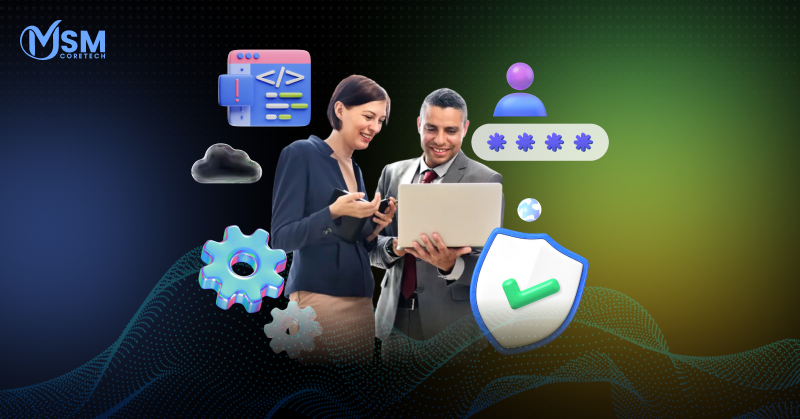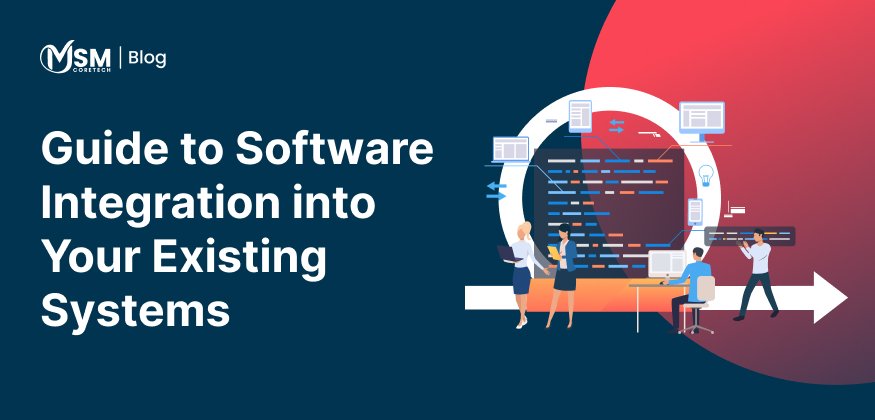How to Integrate Legacy Systems: Key Challenges & Proven Strategies

Legacy system integration is the process of linking modern technologies with legacy systems. This process is necessary for assuring the validity of legacy systems in modern IT surroundings, allowing data to travel across platforms easily.
Moreover, as technology evolves rapidly, developers are looking for more customised systems, as the latest software may require additional effort to operate, and it might not be easy to operate old systems with modern technologies.
For most IT companies , which need highly secured systems such as legacy system integration in banking and insurance organisations, and government procured systems as there are several challenges associated with the integration of modern systems. The legacy system integration market is valued around $24.98 billion in 2025 with an expected growth of 17.92, aiming to reach $932.66 billion by the year 2032.
The blog aims to examine the key difficulties faced by leveraging legacy systems with modern technologies while representing practical strategies to overcome them. In addition, the blog also helps companies in achieving seamless digital transition to enhance efficacy and long-term success.
Comparison Between Legacy Systems and Modern Systems
| Factors | Legacy systems | Modern systems |
| Technology stack | Developed on traditional programming languages and hardware systems. | Utilises cloud-based systems with scalable technologies. |
| User experience | Limited features and outdated templates | Interactive and mobile friendly designs |
| Data management | Often utilises soiled information and presents inconsistent data formats. | Standardized and centralised data for easy accessibility. |
| Maintenance | Requires special skills and high maintenance cost | Easy to upgrade and automated maintenance system. |
| Integration capability | Very low and difficult integration capabilities with low API support. | Easily works with third party applications and tools. |
| Security | Dynamically vulnerable because of outdated systems | Improvised with modern encryption and real-time risk detection. |
Why Businesses Still Rely on Legacy Systems
Legacy systems are traditional software systems that are still being utilised by several organisations for remaining relevant, despite innovation in modern technology. These outdated systems help in smoothing the daily operations of the organisations. There are several reasons why legacy systems are still being used by companies, and some of them are listed below -
- Limited Budget for IT upgrades - Several companies have limited budget plans for their IT upgrades, due to which migrating to modern systems from legacy systems can be cost-prohibitive. While the initial investments of the legacy system are high, they offer low maintenance costs, hardware, and support, which can reduce total expense for long-term success.
- Risk of downtime - Downtime can be a prominent challenge while migrating from the lacy system to the cloud, which can significantly decrease the productivity level and consumer satisfaction. As legacy systems are in palace for a very long-time they have vast data records for being operationally effective, making organisations depend more on them.
- Legacy systems are costly but work effectively - Despite being built on old software, legacy systems can effectively cater to the daily operations. Companies can continue to utilise them as they believe replacing these systems unnecessarily is not useful and can lead to significant challenges.
- Risk of data loss and security breaches - Data is the most crucial asset for any kind of business, and shifting from legacy systems can raise concerns about major data breaches and security risks during the process of integration. Several companies believe that, though their legacy systems are outdated, they offer more stability and security if managed effectively.
- Vendor lock-in - Vendor lock-in is another challenging factor because of which some companies are still using legacy systems, and in some cases, business organisations make long-term legal contracts that bind them from migrating.
Importance of Legacy System Integration in Modern IT Ecosystems
Legacy system integration is the method of connecting traditional systems with modern technologies.
However, rather than migrating your data into an entirely new system (a process that is very risky for enterprises), legacy systems integration helps in better interconnectedness of new and old systems to implement successful digital innovation.
Legacy system integration is achieved through an API integration tool, which decreases the capacity and chances of risks for managing systems effectively.
Benefits of legacy system integration -
- Enhances efficiency - Integration of legacy systems can significantly reduce lagging and can streamline the operational functionality for making it easier to access data across different platforms and departments.
- Improvised consumer experience - Boosts up the consumer experience by offering an overall overview of the user preferences and data across systems.
- Innovation capability - Leveragement of legacy systems offer organisations in adapting dynamic situations easily with the help of leveraging new technologies and modern innovation strategies.
- Robust compliances and security - New-age integration techniques are often developed in consideration of robust security features and compliance support systems.
Real-world case example of successful integration
Real-world examples include banking and financial sector organisations, which need legacy system integration for interlinking their legacy miniframe for performing core transactions into a new CRM software using different APIs for offering enhanced consumer service. Moreover, retail and logistics based organisations integrate low -code platforms within the legacy SAP system for handling and tracking the shipment process.
Top Challenges in Legacy System Integration
Over decades, legacy systems are deeply integrated with multiple components with old patterns with undocumented solutions, as these systems were mainly built to focus on stability rather than adaptability.
However, the main digital transformation challenge is that this architectural difference makes adapting to the situation very risky.
System and platform gaps
Modern IT services aim to offer seamless integration of cloud services, microservices, and different APIs with real-time data analysis. In contrast, legacy system modernization was not developed in the context of these capabilities, which makes modernization a challenging process, as the legacy system can only work within outdated workflows only.
Facing significant data issues
Data protection is a vital factor for legacy system moderation, yet several traditional systems store data in outdated formats such as in the form of old relational databases and flat files. The main challenge arises in migrating this old stored data, which firstly needs to be cleared, transformed, and validated for leveraging effective security measures.
Limited scalability infrastructure
The Majority of the legacy systems were developed in consideration of static workflows operating on fixed virtual platforms. The challenge occurs in the migration process, as without reforming the system, it is impossible for autoscaling and on-demand provisioning, which can eventually hamper the process.
High operating and upgradation costs
As systems become old, they require rigorous efforts in maintaining the smooth flow and managing outdated hardware platforms while fixing the recurring issues. These upgrades lead to cost overruns, which result in low-financial assistance and the capability for future innovation and long-term success.
Organizational resistance and talent gaps
Outdated systems or modern technologies are both inoperable without human intervention, and legacy systems require an ample amount of effort for managing well, which can lead to unnecessary stress and fatigue, which lowers the productivity of the employees.
Strategies to Integrate Legacy Systems Successfully
Legacy system integration strategies are the proven methods that can help you in leveraging a seamless migration process of data for your business. Performing legacy migration is a tough process and for which a well-step process is designed to ease the functioning of the process by using modern techniques.
Analysing the current system
Legacy systems are very typical to understand because in this modern era, no developer utilizes legacy systems due to which there is a significant lack of expertise in this sector. In addition, if you start a legacy integration process without analysing its basic functioning, then it can lead to a major dysfunction in the integration process. Exploring its current tech stack, with an understanding of how and why it works like that, can help very much.
Aligning it with business goals
Determining your business needs is very much necessary for effective legacy integration and helps in developing robust features that meet your current necessities and foster the future growth. Start by finding out the main KPIs that affect the performance of your system and how you can fulfill these KPIs with your new integrations. This approach helps in aligning your business goals with your system for enhanced integration.
Empower modernisation
It is very important for every employee of an IT team to understand the importance of legacy system modernization. After aligning your business goals, you need to develop a wide range of APIs and datasets by which you aim to enhance the integration process, and as it is an important process, it is necessary to leverage the whole idea of modernization to the key stakeholders.
Breaking down the integration process
Legacy integration is a very lengthy process, so it is very helpful to segment it into a step-by-step process for maximising productivity and understanding each team’s performance.
- Considering major costs, features, security, and vendor reputation will be your first step in this process after determining your goal.
- After this, you need to configure the system's reliability for securing the data.
- The last step in this process will be testing and validation of the integrated features for better performance.
Tools and Technologies Supporting Legacy Integration
Applications for supporting Legacy Integration-
- Enterprise service Bus (ESB) - A structured software platform that acts as a main intermediary for communication, fostering data exchange processes between systems. Examples include IBM Integration Bus, Apache Servicemix and Mulesoft.
- Application programming interfaces (APIs) - Newly developed APIs like SOAP and REST can be utilised to identify the functionality within the legacy systems, which can allow them to integrate with new applications easily.
- Extract-transform-load tools (ETL) - These tools help in extracting the data from the legacy systems, reforming it into a whole new format and uploading it into a modern database.
Case Studies: Successful Legacy System Integration Examples
- Private Advisor Group- Private Advisor group is a well-established financial firm, which is facing significant challenges in managing their manual operations in the form of excel spreadsheets, with hours spent monitoring fax machines, manually entering data, and tracking their projects with emails and attachments. The firm decreased its operational costs and expanded their operations with the help of automation processes. Private advisor groups’ consumers are relieved by the simple efficiency of these systems, which frees them from focusing on their clients.
- Medsphere’s - Medsphere Systems Corporation has modernised its supply chain management systems, resulting in a significant increase in the company's market share. With around a 20% reduction in training efforts, Medsphere extended its reach for larger operating systems, increasing their customer satisfaction with good adoption rates. The integration helped Medsphere in offering cutting-edge technology with trusted healthcare IT platforms.
- Swedbank - Swedbank, a fully-functional banking company that has successfully established its core application form Visual basic 6 to visual basic. The integration has successfully resulted in a significant reduction of upgradation hours from 150 to 40, helping the bank in reallocating resources and focusing on future growth.
The Future of Legacy Systems
The future prospect of legacy systems integration consists of digital transformation of modular approaches such as APIs and microservices, using cloud-based environments for more scalability and flexibility, with the leveraging of no-code and low-code platforms to enhance the performance of modernization efforts. The gradual increase in modernization can avoid costly and disruptive replacements, helping businesses to enhance efficacy and enhance analytics for supporting innovation without compromising the quality of existing systems.
Key trends -
- Cloud-based integration - Migration from cloud providers helps in easy scaling of the systems with cloud-native applications, and it also reduces significant cost and offers effective risk management.
- AI and ML integration - Artificial intelligence and machine learning tools help in extracting valuable insights from traditional data systems and enhance security compliances with AI-driven solutions.
Conclusion
It is not easy to shift from one system to another; legacy integration can decrease this uneasiness, as the traditional tools can be still integrated in modern software and technology systems.
While there are some significant challenges in legacy integration, as long as they are aware of these plans properly, companies can achieve a seamless digital transformation with the least stress possible. Moreover, successful legacy integration of modern software is into legacy systems for maintaining operational efficiency and stays competitive. Ultimately, effective legacy system integration requires precise planning, with a clear strategy, while eliminating both technical and non-technical challenges effectively.
FAQs
What is a legacy system integration?
Legacy system integration helps in connecting with the traditional software systems with the help of modern tools utilising different APIs to leverage seamless data flow and functionality.
Why is integration of legacy systems important?
Integration helps in optimizing the operational efficiency, eliminates the soiled data and helps businesses in leveraging modern technologies while compromising the quality of existing systems.
What are the major challenges in legacy system integration?
Key challenges include outdated technology tools, data migration risk, security and compliance gaps and high implementation costs during the integration process.
How can businesses integrate legacy systems effectively?
Leveraging API-first architecture, microservices and cloud migration can significantly help in attaining smooth integration and scalability.
Which industries can have the most benefit through legacy system integration?
Highly secured sectors such as healthcare, banking, government and manufacturing units rely on legacy system modernisation to enhance the speed and user experience.
Related Blogs

Node.js vs Java: Best for Web Development?
Compare Node.js vs Java to understand which backend technology suits your project better — from performance and scalability to development speed and ecosystem support.
Read More

How to Get Started with React Flow - Build Interactive Workflows
Learn how to get started with React Flow in this step-by-step tutorial. Discover how to build interactive, customizable workflows using React Flow’s powerful tools and components.
Read More

Software Integration Guide for Legacy Systems
Discover how to integrate new software into your existing systems to improve efficiency and eliminate data silos. Learn best practices, challenges, and benefits of seamless software integration for growing businesses.
Read More
